Shrub management
 Contact us to choose or optimise your shrub management!
Contact us to choose or optimise your shrub management!
How to achieve some savings?
An adapted and economical shrub pruning may facilitate the right budget balance for the site manager!
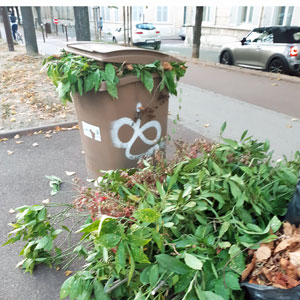
Shrub management represents an important cost!
Shrub management often represents up to 40% of the maintenance time in parks or gardens.
80% of the woody residuals produced by the pruning comes from shrubs.
No doubt, decent management of the physiology of this plant can be cost-effective!
How can you better manage the pruning of shrubs and still maintain their natural volume?
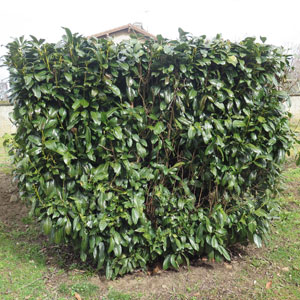
Image opposite: A laurel palm ‘ Prunus laurocerasus ‘ that has been cut inappropriately. Did you know that the Laurel Palm can be a nice little tree with several trunks? This is possible through a simple and unique shaping method as opposed to the rough pruning shown on this photo.
Apart from the aesthetic choice of creating Topiary art, pruning of shrubs is not necessary. This is especially true if the variety of the shrub is adapted to the space assigned to it.
The initial choice of pruning must therefore be adapted to the desired design: hedge or shrub?
How to better manage shrubs in landscaping?
Most shrubs do not require a particular pruning as long as they are suitable for the space assigned to them. In fact, the maintenance pruning of the shrubs also depend on the differentiated management of the areas (very neat or extensive areas).
So, if the shrubs in place are not suitable for their intended function, it may be more efficient to replace them. You may adopt unpruned shrubs and minimum maintenance practices!
For this purpose, we propose to study a planting renewal. In fact, requalify landscaping may be necessary when plantations are unsuitable to the constraints of the site. It may also be the case when the initial landscape design is altered by plants declining.
Studies show that significant management costs are due to the search for:
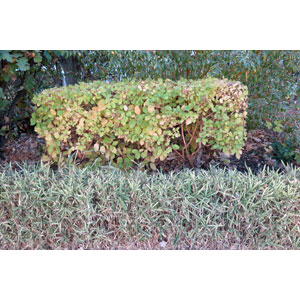
- The control of Shrubs volume,
- Cohabitation pruning resulting from high densities of shrubs,
- Weed control.
As such, optimized shrub management responds to economic requirements for time management and maintenance costs.
However, to optimise the maintenance of shrubs and manage their volume, it is imperative to understand their growth patterns.
Shrub management advices and plan

We can carry out a landscape analysis, a study of the constraints of the site and of the plants present. This in order to help you to optimize Shrub management.
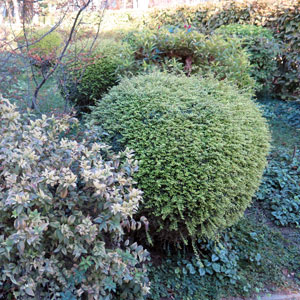
Have you noticed that, following the initial design, time has passed and shrubs have developed too much?
Shrubs evolution may justify a new plantation or a different management, adapted to the available human and financial means.
Learn more about: differentiated management of shrubs.
- What is the planting style planned by the original landscape design?
- What is the density of the plantation?
- Are plant planting distances adapted to their development?
- Are the shrubs healthy?
- What is the plant structure and characteristics of the species (architecture, stage of development, sanitary condition)?
- are shrubs to be preserved or replaced?
The goal is to optimize and reduce pruning interventions while improving landscape quality
As a conclusion, a differentiated management of shrub pruning aims to:
- Optimise some landscape aspects,
- Highlight plants with special characteristics (enhance trunks or stems),
- Take into account the sanitary conditions of certain plants,
- Adapt plant dynamics according to the desired landscape effect,
- Adapt management to the manager’s means.
You shrub is not flowering nor fruiting? Is the pruning not adapted?
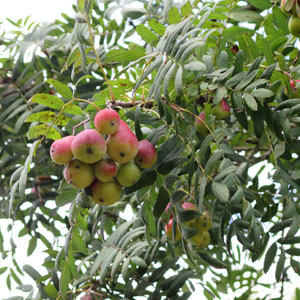
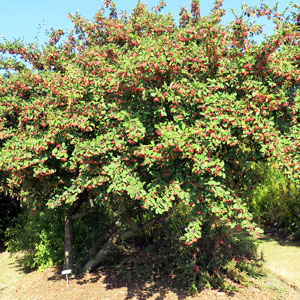
What are your objectives?
The pruning and the pruning period greatly influence the flowering and fruiting of the shrubs.
Shrubs are also a major component of the balance of the ecosystem!
A sustainable differentiated management allows to take into account the environmental impacts of pruning!
A suitable pruning also allows an advantageous flowering!

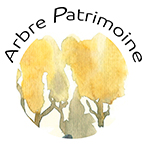 (33)07 60 50 08 70
(33)07 60 50 08 70






